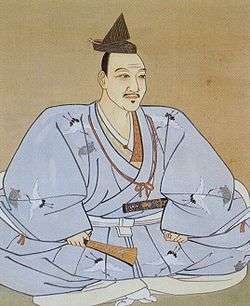Hōjō Ujiyasu
| Hōjō Ujiyasu | |
|---|---|
|
Hōjō Ujiyasu in the painting | |
| Native name | 北条 氏康 |
| Nickname(s) | Lion of Sagami |
| Born | 1515 |
| Died |
October 21, 1571 (aged 55 or 56) Odawara Castle, Sagami Province, Japan |
| Allegiance | Late Hōjō clan |
| Rank | Lord (Daimyō) |
| Battles/wars | |
| Relations |
Father: Hōjō Ujitsuna Mother: Yōjuin-dono |
Hōjō Ujiyasu (北条 氏康, 1515 – October 21, 1571) was the son of Hōjō Ujitsuna (北条 氏綱) and a daimyō (warlord) of the Odawara Hōjō clan. His only known wife was Imagawa Yoshimoto's sister, Suikeiin.
Early years and rise
Upon his father's death in 1541, a number of the Hōjō's enemies sought to take advantage of the opportunity to seize major Hōjō strongholds. Two Uyesugi factions united with the Koga Kubo cause and attacked Kawagoye in 1542 in a night engagement still celebrated in Japanese military annals. "The result was the complete defeat of the Uyesugi forces and the Koga contingent. From that date the Go-Hojo (Later Hojo) as they were called, went on to further triumphs, beginning with the destruction of the Uesugi family."[1]
Siege of Kawagoe
Ōgigayatsu Tomosada tried unsuccessfully to take Edo Castle (江戸城), and a few years later, in 1545, an army led by Ashikaga Haruuji (足利 晴氏) and Uesugi Norimasa (上杉 憲政) besieged Kawagoe Castle (see Siege of Kawagoe (1545)).[2] Hōjō Tsunashige (北条 綱成), the stepson of Ujiyasu's brother Tamemasa (北条 為昌) and son-in-law of Ujitsuna, was outnumbered 3,000 to allegedly 80,000, and Ujiyasu led a relief force of 8,000 soldiers. Ujiyasu slipped a samurai past the enemy lines to inform Tsunashige of the enemy's approach, and made use of ninja to learn of the enemy's strategy and attitude. Using this intelligence, he led a night attack against the Ashikaga/Uesugi force. Despite being vastly outnumbered, the Hōjō army defeated the besiegers because, under Ujiyasu's orders, they were not bulked down by heavy armor, and were not slowed down by seeking to take heads. This battle proved the end of the Ōgigayatsu Uesugi (扇谷上杉家) line and destroyed the prestige of Norimasa of the Yamanouchi Uesugi clan (山内上杉家) as the Governor-General of Kantō region (Kantō kanrei (関東管領)), until Uesugi Kenshin (上杉 謙信), who had subsequently been adopted by Norimasa, assumed the post in 1561.
Allied with Takeda Shingen in 1563, they captured Matsuyama Castle in Musashi Province.[2]:216
Battle of Konodai and Conflict with Shingen
Hōjō Ujiyasu expanded the Hōjō territory, which now covered five provinces, and managed and maintained what his father and grandfather had held. He took Kōnodai in Shimōsa Province in 1564 following a battle against Satomi Yoshihiro (里見 義弘). Towards the end of his life he saw the first major conflicts between his own clan and Takeda Shingen (武田 信玄), who would become one of the greatest warlords of the period. As a response to Hōjō's intervention in his invasion of Suruga Province, Shingen came into Musashi Province from his home province of Kai, attacking Hachigata and Takiyama Castles, where Ujiyasu's sons repulsed them. However, despite the intact castles behind him, Shingen pressed on to the Hōjō central home castle of Odawara (小田原城), burning the castle town and withdrawing after three days. Two of Ujiyasu's seven sons fought Takeda at the battle of Mimasetoge in 1569, ending the first of the Takeda campaigns against the Hōjō.
Death
Subsequently, Ujiyasu managed to make peace with Uesugi Kenshin and Takeda Shingen, the most powerful adversaries of Hōjō, letting his seventh son be adopted by childless Kenshin and accepting the fait accompli of Shingen's reign over Suruga. To cement the ties of Takeda-Imagawa-Hojo, Ujiyasu also gave his two daughters to those two clans; Lady Hayakawa was made as Imagawa Ujizane's wife while Lady Hojo (Hojo Masako) was made as Takeda Katsuyori's second wife. Ujiyasu died in 1571, passing on the Hōjō domains to his eldest son Ujimasa (北条 氏政) in a relatively favourable situation.
Sons
- Hōjō Ujimasa
- Hōjō Ujiteru
- Hōjō Ujikuni
- Hōjō Ujinori
- Hōjō Ujitada
- Hōjō Ujimitsu
- Uesugi Kagetora
References
Additional reading
- Turnbull, Stephen (2002). War in Japan: 1467-1615, Oxford: Osprey Publishing.
